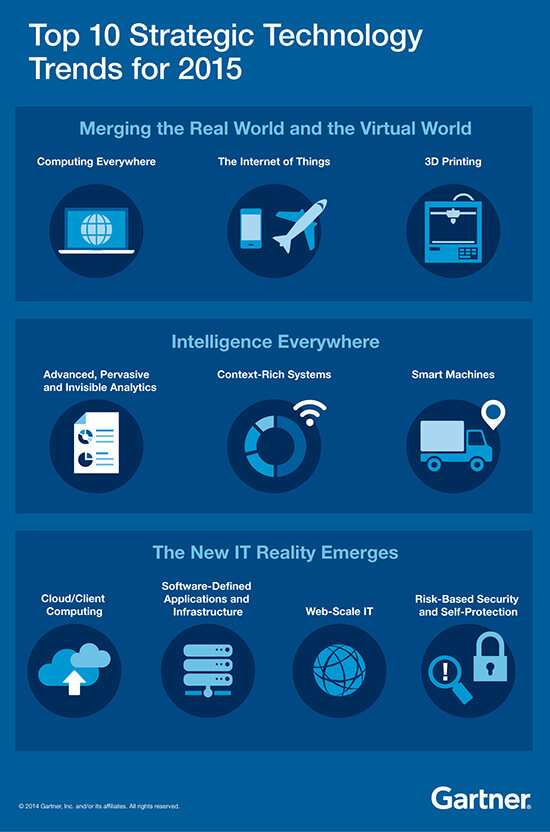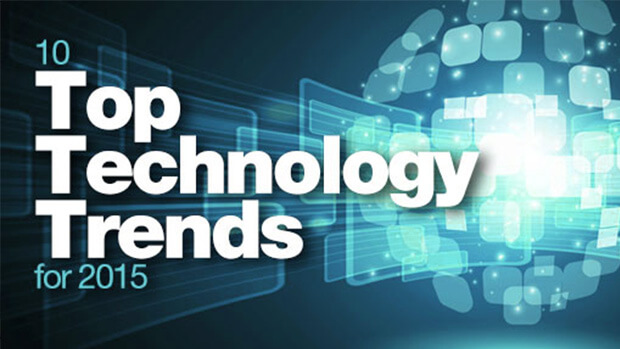Gartner have released their top-ten information technology trends for 2015. Strategic technology trends are defined as having potentially significant impact on organizations in the next three years. Their list comprises:
Computing Everywhere
As mobile devices continue to proliferate, Gartner predicts an increased emphasis on serving the needs of the mobile user in diverse contexts and environments, as opposed to focusing on devices alone. They believe that smart-phones and wearable devices form part of thr broader computing offering that include connected screens in the workplace and in public spaces. David Cearley from Gartner explains “it’s the overall environment that will need to adapt to the requirements of the mobile user. This will continue to raise significant management challenges for IT organizations as they lose control of user endpoint devices. It will also require increased attention to user experience design.”
The Internet of Things (IoT)
The Internet of Things will continue to expand, propelled by user-oriented computing. The combination of data streams and services created by digitising everything creates four basic usage models — Manage, Monetize, Operate and Extend. Organisations need to acknowledge that the Internet of Things has the potential to leverage these models, and identify opportunity to implement change. As the acceptance of Internet connectivity increases, the potential for new business models will expand. For example, the pay-per-use model is becoming standard and applied to assets (such as industrial equipment), services (such as pay-as-you-drive insurance), people (such as movers), places (such as parking spots) and systems (such as cloud services).
3D Printing
Worldwide shipments of 3D printers are expected to grow 98 percent in 2015, followed by a doubling of unit shipments in 2016. 3D printing will reach a tipping point over the next three years as the market for relatively low-cost 3D printing devices continues to grow rapidly and industrial use expands significantly. Gartner highlights that expansion will be especially great in industrial, biomedical and consumer applications, highlighting the extent to which this trend is real, proving that 3D printing is a viable and cost-effective way to reduce costs through improved designs, streamlined prototyping and short-run manufacturing.
Advanced, Pervasive, Invisible Analytics
Analytics will continue to advance due to the Internet of things and greater acceptance of connectivity. Vast pools of structured and unstructured data inside and outside organizations will continue to be generated. Gartner points out that every application will need to be an analytic app. The analysis also concludes that big questions and big answers are more important than big data.
Context-Rich Systems
Embedded intelligence that is ubiquitous combined with pervasive analytics will foster the development of systems that are alert and responsive to surroundings. Gartner highlights that context-aware security is an early application of this trend, but that others will emerge. By understanding the context of a user request, applications can not only adjust their security response but also adjust how information is delivered to the user, greatly simplifying an increasingly complex computing world.
Smart Machines
Deep analytics combined with an understanding of context will usher in smart machines. Advanced algorithms will lead to systems that learn for themselves and act upon those learnings. Gartner notes that machine helpers will continue to evolve from the existing prototypes for autonomous vehicles, advanced robots, virtual personal assistants and smart advisors. The analysis goes on to speculate that the smart machine era will be the most disruptive in the history of IT.
Cloud/Client Architecture
Mobile computing and cloud computing continue to converge and lead to the growth of centrally coordinated applications that can be delivered to any device. Gartner notes that cloud computing is the foundation of elastically scalable, self-service computing for both internally and externally facing applications. Applications that use intelligence and storage of client device effectively will benefit from lowering bandwidth costs, coordination and management will be based on the cloud. In the near term, the focus for cloud/client will be on synchronising content and application state across multiple devices and addressing application portability across devices. Over time, applications will evolve to support simultaneous use of multiple devices.

Software-Defined Infrastructure and Applications
Agile development methods for programming of everything from infrastructure basics to applications is essential to enable organizations to deliver the flexibility required to make the digital business work. Software defined networking, storage, data centers and security are maturing. Application programming interface (API) calls render cloud services software configurable, and applications have rich APIs to access their function and content programmatically. Gartner notes that in order to deal with the rapidly changing demands of digital business requires computing to move away from static to dynamic models.
Web-Scale IT
Web-scale IT is a pattern of global-class computing that delivers the capabilities of large cloud service providers within a business IT setting. More organisations will begin thinking, acting and building applications and infrastructure like Web giants such as Amazon, Google and Facebook as cloud technology grows in acceptance. This will be compunded as commercial hardware platforms embrace the new models and cloud-optimised and software-defined methods become mainstream. Gartner notes that the marriage of development and operations in a coordinated way (referred to as DevOps) is the first step towards the web-scale IT.
Risk-Based Security and Self-Protection
Security continues to underpin everything, however organisations will increasingly recognise that it is not possible to provide a 100 percent secured environment. Once they acknowledge that, they can begin to apply more-sophisticated risk assessment and mitigation tools. Applications need to take a more active role in security gives rise to a new multifaceted approach. Security-aware application design, dynamic and static application security testing, and runtime application self-protection combined with active context-aware and adaptive access controls are all needed in today’s dangerous digital world. This will lead to new models of building security directly into applications. Security aware application design, dynamic and static application security testing, and runtime application self-protection, combined with active context-aware and adaptive access controls will all be necessary.
To learn more about Gartner and their reports, visit www.gartner.com.
For strategic advise on how to leverage these trends in your business, contact blueAPACHE.

